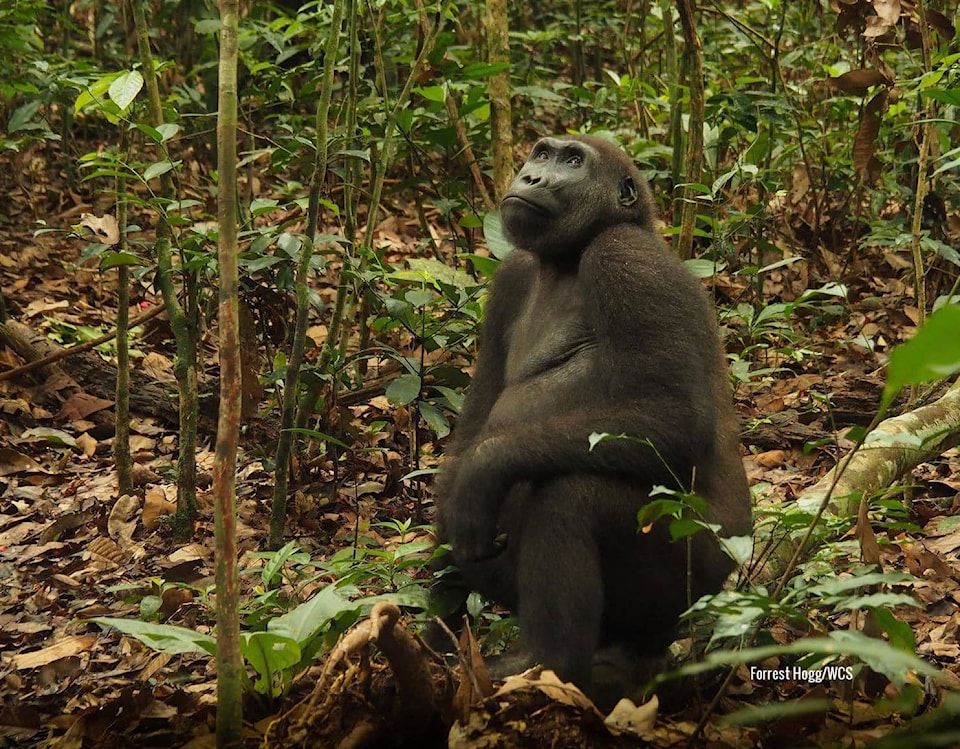The largest-ever survey of two primate populations in Africa found vastly more western lowland gorillas, as well as higher numbers of central chimpanzees, than were previously believed to exist. But that hopeful finding is imperilled because of the gorillas’ alarming rate of decline, according to a study.
Western lowland gorillas are the primary and most widespread subspecies of gorilla, and central chimpanzees are the second-most populous chimp, outnumbered only by the eastern chimpanzee. Both species are found mainly in the Congo and Gabon.
The study, published Wednesday in the journal Science Advances, estimates that there were 361,900 gorillas and 128,700 chimpanzees as of 2013. That’s about one-third more gorillas and one-tenth more chimpanzees than previous surveys estimated, though those calculations were done differently and were not designed to count the animals across their entire range.
That is the good news. Now the bad: Researchers found that gorilla populations are dropping faster than they believed, at a rate of nearly 3 percent per year, said Fiona Maisels, a conservation scientist with the Wildlife Conservation Society and the University of Stirling in Scotland. At this rate, half of the world’s gorillas could be gone by about 2040, she said.
“It’s nice to know there are more, but it was kind of shocking to see that the gorillas are declining as much as we calculated,” she said.
This means that even when taking a larger population into account, western lowland gorillas are correctly classified as “critically endangered” by the International Union for Conservation of Nature (IUCN), said Russell Mittermeier, chair of the society’s primate specialist group. Chimpanzees are listed as endangered.
The gorilla numbers are probably already lower than reported. The most recent data point incorporated into the study is five years old, Maisels noted, because of the enormous amount of information that had to be gathered and analyzed.
“If the decline has gone on at the same speed, by 2020, we will have lost another 60,000 gorillas,” she said.
What’s more, the study said, about 80 percent of both animals are found outside protected areas, which means they could be more vulnerable than previously assumed.
To come up with the new estimate, a team of more than 50 scientists and conservationists analyzed and gathered a decade’s worth of data from the countries where the two animals are found: Congo, Gabon, Cameroon, the Central African Republic, Equatorial Guinea and Angola. The work included surveys in an area the size of Washington state.
Researchers hailed from a dozen organizations, including the World Wide Fund for Nature, the Jane Goodall Institute and the Convention on International Trade in Endangered Species, or CITES. Scientists collectively spent 61,000 days in the field gathering data, the Wildlife Conservation Society said in a statement.
The researchers developed a computer model to predict densities of gorillas and chimps outside the areas directly surveyed, over the whole of their Texas-size range.
Scientists also conducted surveys by walking straight lines, or transects, in 59 areas of tropical forest in the region, known as Western Equatorial Africa. Along these lines, they would count gorilla and chimpanzee nests, which the animals make each night for sleeping. The number and condition of these resting places were key building blocks of the final population estimates, Maisels said.
Both animals are threatened by hunting and the bushmeat trade, as well as logging, forest degradation and agricultural expansion. The Ebola virus, which affects both animals, has also taken a toll.
“We need far better management of existing parks and reserves, and we need to have more protected areas, since large portions of chimp and gorilla populations occur outside” them, said Mittermeier, who is the chief conservation officer for Global Wildlife Conservation and was not involved in the study.
Gorillas and chimps can survive in areas that are managed responsibly, said Maisels, who said she would like to see stronger enforcement of laws and hunting prohibitions from logging companies within areas they manage. But laws against illegal logging and hunting are not always observed, and the roads that loggers build through forests can allow poachers to more easily access and kill wildlife within.
To keep the animals around, “we have to make sure the protected areas are truly protected,” Maisels said.
One obvious reason to save gorillas and chimps is that they are huge draws for ecotourism, a growing source of revenue throughout the area. They also help keep forests healthy, including by spreading seeds. Their forest habitats hold massive stores of carbon, which has its own economic value, Mittermeier said.
But maintaining robust wild populations is about more than that, Maisels argued.
“They’re our nearest relative,” she said. “It’s a kind of moral responsibility.”
Douglas Main/The Washington Post
